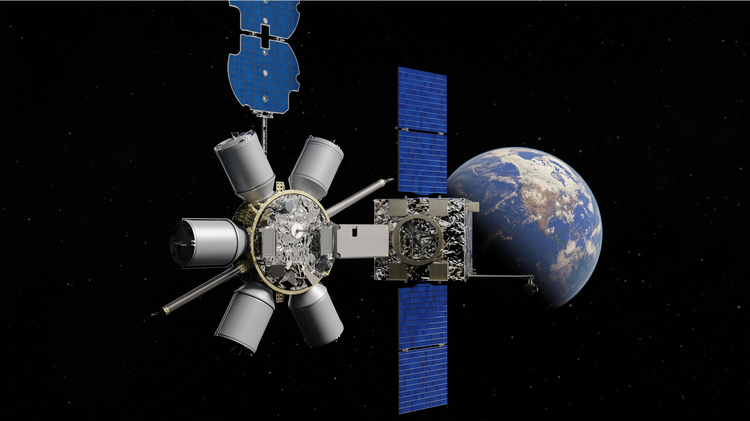Introduction:
The Polywell is a concept for a fusion reactor. It uses an electric field to heat ions to fusion conditions. It was recently explored by the US Navy and EMC2 inc. In July, the company published their newest findings in the Journal Physical Reviews X. Their paper was intriguing.
The major claim of the work was that cusp confinement was seen experimentally. In its simplest form, cusp confinement happens when a plasma rejects a magnetic field. This condition was first predicted in 1958; but has never been seen experimentally [2, 8]. Plasma is a soup of ions and electrons. As they move, they generate small magnetic fields. This allows plasma to have magnetic proprieties [6]. In a cusp confined system, these small magnetic fields push out the outside field [5, 3]. This makes a sharp boundary between a magnetic field and a plasma [4, 8]. This would be wholly unique. Normally, plasma and magnetic fields mix and mingle.It is still too early to know if this is the effect that EMC2 observed. One experiment is not enough to verify a finding of such importance. We need additional qualified, funded teams to try and duplicate these results. But if true, it would be a totally new experimental system in plasma physics. Indeed, this kind of trap may trump any other plasma traps we have ever built. That would change how we might build a fusion power plant, what it looks like and how soon we might expect one.
EMC2 and the Navy are not alone on this path. Lockheed Martin is also chasing cusp confinement. Last year, the defense giant announced a fusion reactor research program at their super secretive Skunk Works facility in California. Sadly, Lockheed has failed to publish any of their work in a peer-reviewed journal. This is a poor decision. We cannot truly assess the validity of Lockheed’s claims with verifiable data. We cannot build on what they find; especially if things don’t work out. No organization has enough credibility to claim fusion power to the public, without verifiable evidence. What we do know come from three Lockheed patents, news reports and a presentation at Princeton last month [7, 9-11]. In that presentation, lead researcher Dr. Tom McGuire lays out a trapping scheme very similar to the Polywell; cusp confinement. Lockheeds’ method of heating is different. The polywell uses an electric field to heat ions to fusion conditions, while Lockheed is shooting in high energy neutral plasma [7]. It seems as though these efforts are tied together.
There are also commercial polywell efforts. A startup named Convergent Scientific Inc is working to develop the polywell technology. The California based company has been at it for over five years. In that time, they have developed an experimental system which has trapped plasma for tens of seconds [13]. The company also has a piece of software custom built to solve this problem as well as a patent in the polywell space [14].
Electric Fusion
The Polywell is part of a larger field known as inertial electrostatic confinement fusion. This is a branch of fusion research which uses electric fields to heat ions to fusion conditions. The most common machine in this field is the fusor. Fusors are great: they are simple, cheap and they work well. They are simple enough that high school students can build them in their garage. Over 75 amateurs in North America have gotten fusion using a fusor [12]. The community of amateurs is close knit; they use Fusor.net to collaborate online. The most famous member of this community is Taylor Wilson. Taylor became famous for fusing the atom at fourteen years old. A great book about Taylors’ life was just published by Tom Clynes. “The Boy Who Played With Fusion” is an interesting read on extreme parenting, fusion and STEM education.
One of the best amateur fusion groups in the US is the Northwest Nuclear Consortium. The Seattle based group is the only high school club in America with regular access to a fusion device. Founded in 2010, the club of roughly 20 students meets every Friday in a home in Federal Way Washington, to do nuclear fusion. They have won over $660,000 in college scholarships and came in fourth place – worldwide – in the 2015 Intel International Science and Engineering Fair [15,16]. Incredibly, these teenagers can routinely do a million fusion reactions per second – for hours continuously – in a basement [17].
Fusors have had a long history. The modern fusor was first developed by Philo Farnsworth and Robert Hirsch in 1967 [18]. Farnsworth was a famous inventor; he is credited with the invention of the television. Hirsch is now well known energy analyst in Washington DC. A fusor consists of two wire cages in a vacuum. These cages are built, one inside the other. A voltage is placed between these two fusors; a minimum of 10,000 volts is needed [1]. Positive ions are sent into the chamber. They feel the voltage drop and fall towards the inner cage. As they fall, the pick up speed, heating up to fusion conditions. If they miss the inner cage, they can collide in the center and fuse.
It is that last step – missing the inner cage – is what limits the fusors’ ability to get net power. Most material hits the inner cage, which limits the machines’ efficiency. We put tons of energy in, but can only get a small amount of energy out. These flaws have not stopped companies from commercializing this technology – in other non-energy applications. Two stand outs are Phoenix Nuclear Labs and its’ sister company Shine Medical Technologies. Phoenix Nuclear Labs took the fusor concept and supped it up, using beams to build the worlds’ strongest commercial neutron generators [22]. Shine was spun out of PNL to take that technology and use it to make medical isotopes. This is a multi-billion dollar market; and Shine likely has the best solution [19]. Shine just signed a $125 million deal to build two medical isotope plants. The company also secured an exclusive supply agreement with GE Healthcare [20, 21].
Conclusion: The Polywells’ Future
The premise of the Polywell, is to beat the fusors’ problems by creating the voltage drop, with a cloud of mostly negative plasma. The idea is to remove the inner cage; removing those conduction limits placed on the fusor. Cusp confinement would be a really handy tool for this – if it works. Right now, EMC2 is hunting for $30 million over three years to test this concept. At his latest talk at Microsoft Research, EMC2 laid out their road map on how to get there [8]. If the company is right, it would have profound impact on our energy industry. An impact we likely cannot fully understand.
Citations:
1. “Development of the Indirect-drive Approach to Inertial Confinement Fusion and the Target Physics Basis for Ignition and Gain.” John Lindl. Page: 3937. AIP Physics of Plasma. American Institute of Physics, 14 June 1995.
2. J. Berkowitz, K. O. Friedrichs, H. Goertzel, H. Grad, J. Killeen, and E. Rubin, in Proceedings of the Second U.N. International Conference on Peaceful Uses of Atomic Energy, Geneva, 1958 (United Nations, Geneva, 1958), Vol. 31, p. 171.
3. Park, Jaeyoung, Nicholas A. Krall, and Paul E. Sieck. “High-Energy Electron Confinement in a Magnetic Cusp Configuration.” Physical Review X. N.p., 11 June 2015. Web. 28 Sept. 2015.
4. Grad, Harold. “Plasma Trapping in Cusped Geometries.” Physical Review Letters 4.5 (1960): 222-223.
5. Haines, M. g. “Plasma Containment in Cusp-shaped Magnetic Fields.” Nuclear Fusion 17.4 (1977): 811-58.
6. Cole, K. D. “Diamagnetism in a Plasma.” Physics of Plasmas Phys. Plasmas 4.6 (1997): 2072.
7. McGuire, Tom. “The Lockheed Marin Compact Fusion Reactor.” Thursday Colloquium. Princeton Plasma Physics Lab, Princeton. 6 Aug. 2015. Lecture.
8. Park, Jaeyoung. “Polywell Fusion: Electrostatic Fusion in a Magnetic Cusp.” Microsoft Research: Visiting Speaker Series. Microsoft Research, Seattle. 22 Jan. 2015. Lecture.
9. McGuire, Thomas. Heating Plasma for Fusion Power Using Magnetic Field Oscillations. Baker Botts LLP, assignee. Issued: 4/2/14, Patent 14/243,447. N.d. Print.
10. McGuire, Thomas. Magnetic Field Plasma Confinement for Compact Fusion Power. US Patent Application, assignee. Patent 14/242,999. 2 Apr. 2014. Print.
11. McGuire, Thomas. Magnetic Field Plasma Confinement for Compact Fusion Power. World Intellectual Property Organization, assignee. Patent WO 2014/165641 A1. 9 Oct. 2014. Print.
12. Hull, Richard. “The Fusor List.” The Open Source Fusor Research Consortium II – Download Complete Thread. 58. Http://www.fusor.net/board/download_thread.php?site=fusor&bn=fusor_announce&thread=1022854449, 22 Mar. 2013. Web. 04 Apr. 2013.
13. “Some Questions about Your Work.” Interview by Devlin Baker. Email 16 Jan. 2014: n. pag. Web. 17 Jan. 2014.
14. Baker, Devlin. Method and Apparatus for Electrical, Mechanical and Thermal Isolation of Superconductive Magnets. Magnetic-Electrostatic Confinement (Mec) Corporation, assignee. Patent US8279030 B2. 26 Sept. 2009. Print.
15. Greninger, Carl. “About Us.” The Northwest Nuclear Consortium. The Northwest Nuclear Consortium, n.d. Web. 04 Oct. 2015.
16. Greninger, Carl. “Building Ultra-STEM for AP Teens by Carl Greninger.” GoFundMe.com. Northwest Nuclear Consortium, n.d. Web. 04 Oct. 2015.
17. Grengniner, Carl. “Fusion In A Basement.” YouTube. The Northwest Nuclear Consortium, 14 Oct. 2014. Web. 04 Oct. 2015.
18. Robert L. Hirsch, “Inertial-Electrostatic Confinement of Ionized Fusion Gases”, Journal of Applied Physics, v. 38, no. 7, October 1967
19. Mraz, Stephen. “Company To Build Reactor and Supply Medical Industry with Moly 99.” Company To Build Reactor and Supply Medical Industry with Moly 99. Machine Design, 9 Sept. 2014. Web. 04 Oct. 2015.
20. “SHINE Medical Technologies to Supply Moly-99 to GE Healthcare.” SHINE Medical Technologies. SHINE Medical Technologies™, 3 Apr. 2014. Web. 04 Oct. 2015.
21. “SHINE Medical Signs $125 Million Term Sheet.” SHINE Medical Technologies. N.p., 10 Oct. 2014. Web. 04 Oct. 2015.
22. Sengbusch, Evan. “The World’s Strongest Commercial Neutron Generators.” Phoenix Nuclear Labs, Aug. 2014. Web. 4 Oct. 2015.









